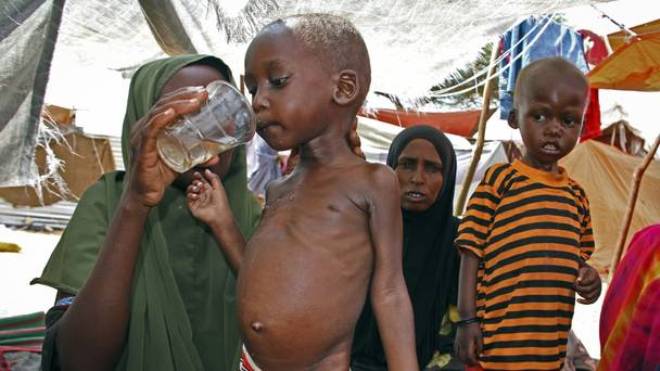
Peter Power
Thursday June 1, 2017
THE famine that was declared in parts of South Sudan earlier this year is threatening to spread. In Somalia, millions of children are at risk of death.
We have been here before. We know this crisis. In 2011, 130,000 children died in Somalia because we did not act quickly enough. We have the skills to prevent that from happening again. These thoughts have been tormenting me this week, as I meet children on the frontline of hunger.
South Sudan’s declaration of famine came in February. Somalia is currently categorised as one level below that on a five-level scale used by humanitarian organisations to assess famine risk. This week, I have come to some of the areas worst-affected by that crisis in Somaliland, Northern Somalia. The situation here was caused when the rains failed six months ago and a drought occurred.
If they are to live, children in Somalia need food and clean water, vaccinations and medicine. 275,000 children currently have, or will suffer with Severe Acute Malnutrition (SAM) this year. SAM is what we call malnutrition when it reaches the life-threatening stage. But 1.4 million children are currently malnourished in total. In South Sudan, Nigeria and Yemen, the other key crisis countries affected by this famine crisis, the numbers of malnourished are even greater.
On Tuesday I met eight-month-old baby boy Hassan and his Mother Ugaso at the Hargeisa Stabilisation Centre for severely malnourished children with complications in the regional capital, Hargeisa. Hassan, who was already weak, had been vomiting when he was brought in five days ago after being referred by a maternal and child health centre. His poor Mum was very shaken by her infant’s brush with death. Thankfully, Hassan is now getting the treatment he needs and has an excellent chance of making a full recovery.
Over 680,000 people – the vast majority of them women and children – have already been displaced by drought since November 2016. The Gu (April-June) rains have arrived in many parts of the country, bringing flash floods. However, other areas have still had little or no rain. Most of the 260,000 victims of Somalia’s 2011 famine died because they were forced to leave their homes in search of food and water.
At the village of Sheikh Noor I met another Mother, Nada Hassan and her family, who set out from their home near Burao in Eastern Somaliland in January, and walked for six weeks to get to safety after drought killed most of their sheep and goats. They lost 430 of 500 animals, and their livelihood. Nada Hassan has eight children aged from 12 to 20.
When they do come, the rains bring with them an increased risk of deadly diseases. When a child is weakened by a lack of food and water, they do not have the natural defences to protect themselves from cholera, measles or diarrhoea. Severely malnourished children are nine times more likely to die from these diseases.
So what connects Somalia, South Sudan, Nigeria and Yemen? It is isn’t geography, it is conflict. This has in fact been termed a man-made crisis. Somalia has been lawless for decades; South Sudan – the World’s newest State – has only ever known conflict in its six short years. In Nigeria, Boko Haram is causing insecurity and in Yemen a tangled civil war is playing out with international actors. One of the outcomes of conflict is that families flee, causing more displacement.
Famine, conflict and displacement are conditions we Irish know well.
I am visiting UNICEF’s programmes in Northern Somalia, where our teams on the ground are working tirelessly to pull off a massive famine prevention programme.
UNICEF nutritional experts urgently need funding to buy 1.2 million cartons of ready-to-use-therapeutic-food for Somalia, South Sudan, north-east Nigeria and Yemen.
In Somalia in 2011, major funding only came in famine was declared in July – too late for the 130,000 children who were already dead. We are determined not to let that happen again.
This year, UNICEF and its partners have already treated nearly 70,000 children with Severe Acute Malnutrition at 330 new nutrition centres. Those children have an almost 93% recovery rate. UNICEF aid workers have given 1.2 million people access to safe water. Crucially, 280,000 children have been vaccinated against measles while 900,000 people were given oral cholera vaccines.
The people of Somalia don’t know what lies ahead, it could be that the worst is yet to come. But there is another possible outcome. Famine is preventable. Let’s prevent it.